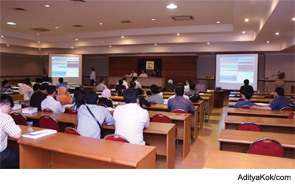Think you need to brush up on your presenting skills? Chances are you probably do. According to Benjamin Asher, MD, founder of Asher Integrative Ear, Nose & Throat in New York City, public speaking is something physicians are rarely trained for.
“[Physicians] either think they don’t have the time or they don’t need it,” he says. A seasoned presenter, Dr. Asher says he knows what it’s like to become uneasy in the middle of a presentation, and he says even a highly confident speaker will benefit from taking the time to refine his or her presentation skills. That’s what he did, working with coaches to help him warm up and feel grounded at the podium, project his voice, and speak at an appropriate speed.
“It makes a huge difference to be able to give a talk that’s bright and has everybody behind it and that is engaging for the audience to hear,” Dr. Asher says. “In my experience, there’s not a person out there who’s an engaging speaker that hasn’t worked at honing the craft.”
Whether you’ve given hundreds of presentations throughout your career or are preparing for your first conference lecture, there’s always room for improvement when it comes to professional speaking.
Practice, Practice, Practice
Preparation may seem like an obvious tip, but it’s one that’s often overlooked, either due to time constraints or overconfidence, says George M. Hall, PhD, DSc, professor of anesthesia at St. George’s University of London in the UK and author of How to Present at Meetings, 3rd edition (Wiley, 2012). (Disclaimer: Wiley is also the publisher of The Rheumatologist.) “The problem with senior presenters such as myself is that as we get old we think we can skimp on the preparation and the rehearsal and then we give a poor presentation,” he says.
Sticking to a rule of thumb given to him by a professor years ago, Dr. Hall suggests one hour of preparation for every minute of a presentation. “That’s hopefully a little bit too much if you’re particularly familiar with the topic, but if you’re starting from scratch, it’s probably about right.”
Part of preparing is developing a practical core message with an opening that captures the audience’s attention, says Susan Miller, PhD, a speech pathologist and CEO and founder of the Voicetrainer, LLC, a voice coaching and communication consulting business. “That might be a fact that gets the audience thinking about the prevalence or relevance of a topic,” she says.
Presenters should also identify two or three points they want to develop and create a strong closing, she adds. “It should be something that will make people remember what you said weeks or even months later.”
Having a clear message frees speakers to focus on another key aspect of effective presenting: body language.
Pay Attention to Body Language
Having a clear message frees speakers to focus on another key aspect of effective presenting: body language. “When you’re actually delivering your presentation, you have to remember: I really know this message, now I need to use powerful body language,” Dr. Miller says. “I need to look comfortable, maintain eye contact, stand tall, and use a voice that’s heard.”
Jannette Collins, MD, Ben Felson professor and chair of radiology and professor of medicine at the University of Cincinnati College of Medicine, who regularly gives faculty workshops on delivering effective presentations at Radiological Society of North America Annual Meetings, says she counsels physicians in her specialty to deliver in a conversational yet professional manner, varying the volume and pace of their speech. “An example I use is delivery of a paragraph that’s monotone with no change in voice inflection. I ask the person, ‘If that is not how you talk to a friend, then why would you speak that way when talking to an audience?’”
She also says speakers should move around, as opposed to being fixed at a podium, and they should make broad, open-handed gestures to the audience, being careful not to point fingers or wave their fists, which can be seen as threatening.
Get the Audience Involved
Involving the audience in your presentation is the easiest way to sustain their attention Dr. Collins says, and there are numerous ways to make even a presentation to thousands of people interactive. “You can ask rhetorical questions, ask for a show of hands, ask members of the audience to interact with the people next to them or write down an idea,” she says. She also suggests giving clinical scenarios and asking audience members what they would recommend for further management, or even using volunteers for role playing.
When it comes to a lay audience, Dr. Hall says you should pause for questions throughout the presentation so you don’t lose their attention as time passes. Using props may also be effective for this type of listener, Dr. Miller notes. “If the presentation is about smoking, you may want to bring a pack of cigarettes,” she says.
e-Tips for Effective Presentations

- American College of Physicians: Scott C. Litin, MD, discusses how to improve presentation skills in a 60-minute session: playbackacp.com
- Yale Medical Library: Whether you need a guide to PowerPoint, slide templates, or medical images to include in your presentation, Yale’s online medical library can direct you to the source: med.yale.edu/library/education/powerpoint.html
Use PowerPoint, Sparingly
Rarely will a speaker give a presentation without using PowerPoint, but the program has become fatally easy, Dr. Hall says. “The problem is people try to cram too much info in too short a space of time, and you suffer from PowerPoint overload.” To prevent that from happening, he suggests having no more than one slide per minute of a presentation.
Dr. Miller has her own rule of thumb when it comes to PowerPoint: no more than six lines on a slide. “Presenters typically use busy, data-driven slides. Use simple graphs or emphasize the important statistics in a different color,” she suggests, noting that a well-chosen visual can significantly reduce the time needed to present a concept. “Visuals should be bold and brilliant, and they should be fully integrated into the presentation.”
Think on Your Feet
One key skill physicians traditionally haven’t been able to master is sensing the mood of the audience and altering their presentation accordingly, Dr. Hall says, adding that this is a huge aspect of keeping the audience engaged.
“Stand-up comedians sense how their presentation is going and alter it to the mood of the audience, and I think that is what really good medical presenters can do as well.” Although he says this capability isn’t something that can be taught, there are ways physicians can become more in tune with their audience. Dr. Collins suggests testing listeners using an audience response system prior to beginning a presentation. The remotes allow audience members to answer questions using the hand-held key pad so that presenters can query the audience to learn more about what they know and tailor the presentation accordingly. As Dr. Collins points out, the more prepared you are, the easier this will be.
“By rehearsing and being familiar with the content, you can alter a presentation so that if a question comes up about something you planned to talk about later, you can jump ahead to that information or tell the audience you plan to cover it,” he says.
Because no two presentations are the same, improving your speaking skills is something that you should build upon with each engagement, Dr. Hall says. “It’s a bit like show business. You’re only as good as your last presentation, because that’s the one that people remember.”
Brande Victorian is a freelance writer based in Toledo, Ohio.
Adapted with permission from ENT Today (2012;7 (4):14, 16).
Top Mistakes
Public speaking experts say they see doctors make certain mistakes time and time again in their presentations. See if you’re guilty of making one of these common errors.
- Trying to present too much information in a short period of time. “The purpose of a 20-, 30-, 45-minute, or hour-long talk is not to present as much as you possibly can, but to concentrate on two or three key facts or themes and emphasize those over and over during the presentation,” Dr. Collins says.
- Not grabbing the audience’s attention first. “Doctors know the research,” Dr. Miller says. “They’re experts, so they don’t think, ‘I have to hook this audience,’ and they don’t think about delivering in a way to maintain interest.”
- Bad PowerPoint transitions. “The presentation becomes more important than the context,” Dr. Hall says. “With all the gizmos, it’s very easy to be distracted by clever transitions from slide to slide, and that takes precedent over what you’re trying to say.”
- Losing your cool. “I have seen it, and it must never, ever happen,” Dr. Hall says. “If you think a questioner is trying to pick an argument with you, you have to diffuse the situation.” One way to do this is by offering to speak with the questioner in private, after the talk is over, he says.



